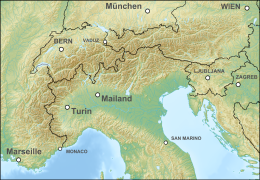Carnia
Carnia , Italian Carnia , furlanisch Cjargne (standard), Cjargna, Cjargno (local dialect) is an area in the Carnic Alps , in north-eastern Italy in the Friuli-Venezia Giulia region , province of Udine . The central place is Tolmezzo .
Location and landscape
The valley landscape lies between the Carnic Main Ridge and the Carnic Pre-Alps , on the uppermost Tagliamento . It forms the north-west of the Friuli countryside .
In the north it borders on Carinthia in Austria , in the west on the Cadore in Veneto , in the south on the province of Pordenone , in the east on Canal del Ferro - Val Canale .
The Carnic Valleys
Carnia has four main valleys - the name canale , furlanic cjanâl describes the straight lines typical of the area.
- Valle del But , Canale di San Pietro (Cjanâl di Sant Pieri)
- Val Chiarsò , Canale di Incaroio (Cjanâl di Incjaroi)
- Val Degano , Canale di Gorto (Cjanâl di Guart)
- The upper Tagliamento valley (Cjanâl di Soclêf, Petecarie) to the confluence of the Fella river .
Smaller side valleys are:
- Valcalda (Valcjalde, Cjanâl di Monai)
- Val Lumiei (Valade dal Lumiei)
- Val Pesarina (Cjanâl Pedarç)
- Val Pontaiba (Val Pontaibe)
Communities
The 27 municipalities of Carnia are:
- Amaro (Damâr), Ampezzo (Dimpeç), Arta Terme (Darte), Cavazzo Carnico (Cjavaç), Cercivento (Çurçuvint), Comeglians (Comelians, loc. Comalians), Enemonzo (Enemonç), Forni Avoltri (For di Avoltri, loc. Fôr Davuatri), Forni di Sopra (Fôr Disore), Forni di Sotto (Fôr Disot), Lauco (Lauc), Ovaro (Davâr), Paluzza (Paluce), Paularo (Paulâr), Prato Carnico (Prât), Preone (Preon) , Ravascletto (Ravasclêt, loc. Monai) Raveo (Raviei) Rigolato (Rigulât) Sauris (dt. Zahre) Socchieve (Soclêf) Sutrio (Sudri) Tolmezzo (Tumieç) Treppo Ligosullo (Trep Liussûl) Verzegnis (loc. Verzegnas), Villa Santina (Vile), Zuglio (Zui)
history
Carnia was from the 4th century BC. . BC the Celtic tribe of Karnier inhabited, of which today's country and landscapes Carinthia and Carnia have their names. Already in the 2nd century BC The area was conquered by the Romans. With the fall of the Roman Empire, the area first came under the rule of the Ostrogoths, of whom some Gothic words have been preserved in Furlan, then the Lombards. In the 8th century Carnia came under the rule of the Carolingians and subsequently (825 - 976) to the Carantania (Carinthia) belonging to the Duchy of Bavaria, the later Duchy of Carinthia (from 976). From the end of the 11th century it was incorporated into the Patriarchate of Aquileia by Emperor Heinrich IV . With the conquest of the patriarchate by the Republic of Venice , Carnia came under Venetian rule in 1420 and left the Roman-German Empire . In 1796 it came with Veneto to Austria , in 1866 to Italy .
Culture
The official and colloquial language is Italian . The local population largely speaks Furlan , a Romansh language . In addition, the German language islands of Zahre ( Sauris ) and Tischlwang ( Timau ) have been preserved, in which German is spoken in Tyrolean (mainly Pustertal ) or Carinthian dialect . The German language islands of Carnia are now in close contact with the German language islands in the Canal Valley , in Veneto ( Bladen , seven municipalities , thirteen municipalities ) and in Trentino ( Lusern and Fersental ).
literature
- Eva Bakos (text), Gerold Jung (photos): Friuli Trieste Veneto. Land behind the beach (DuMont Travel Right). 5th edition. DuMont Buchverlag, Cologne 1991, ISBN 3-7701-1712-3 , pp. 194-209.
historical:
- Niccolò Grassi, Notes storiche della Provincia della Carnia , Udine, fratelli Gallici alla Fontana, 1782.
- Giovanni Marinelli: Guida della Carnia (Bacino superiore del Tagliamento) , Udine, Del Bianco, 1898, 1912.
Special:
- Pietro Adami: La cucina carnica . Gruppo Editoriale Muzzio, 2009. ISBN 978-88-96159-14-9 .
- Furio Bianco: Carnia XVII-XIX. Organizazione comunitaria e strutture economiche nel sistema alpino . Pordenone, Biblioteca dell'Immagine, 1985, 2002.
- Flavia De Vitt: Pievi e parrocchia della Carnia nel tardo Medioevo (secc. XIII-XIV) . Tolmezzo, Società Filolo-gica Friulana / Edizioni Aquileia, 1983.
- Giovanni Edoardo Nogaro - Adriano Alpago Novello: Carnia. Architettura spontanea e costume . Paderno Dugnano, Görlich editore, 1973.
- Lodovico Zanini: La casa e la vita in Carnia . Udine, Arti Grafiche Friulane, 1968.
Web links
Coordinates: 46 ° 23 ′ 40 ″ N , 12 ° 46 ′ 27 ″ E

